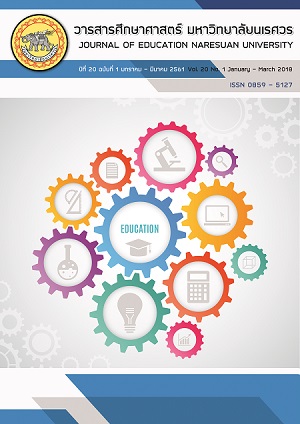การพัฒนาอีเลิร์นนิ่งเพื่อชุมชนการเรียนรู้ทางวิชาชีพในมหาวิทยาลัยมหามกุฏราชวิทยาลัยวิทยาเขตอีสาน: การวิจัยเชิงปฏิบัติการแบบมีส่วนร่วม; E-LEARNING DEVELOPMENT FOR PROFESSIONAL LEARNING COMMUNITY IN MAHAMAKUT BUDDHIST UNIVERSITY, ISAN CAMPUS...
Main Article Content
Abstract
การวิจัยนี้มีวัตถุประสงค์เพื่อศึกษาผลการเปลี่ยนแปลง การเรียนรู้ และองค์ความรู้ใหม่ที่เกิดขึ้นจาก การพัฒนาอีเลิร์นนิ่งเพื่อชุมชนการเรียนรู้ทางวิชาชีพในมหาวิทยาลัยมหามกุฏราชวิทยาลัย วิทยาเขตอีสานด้วยกระบวนการวิจัยเชิงปฏิบัติการแบบมีส่วนร่วม โดยผู้วิจัยและผู้ร่วมวิจัยที่เป็นอาจารย์ผู้รับผิดชอบหลักสูตรสาขาวิชาต่างๆ จำนวน 15 รูป/คน และนักศึกษา จำนวน 140 รูป/คน ผลการวิจัย พบว่า มหาวิทยาลัยมหามกุฏราชวิทยาลัย วิทยาเขตอีสานมีบทเรียนอีเลิร์นนิ่งเสริมการเรียนการสอนให้นักศึกษาได้เรียนรู้ด้วยตนเองนอกเวลาเรียนได้ทุกที่ ทุกเวลา จำนวน 15 รายวิชา และ ได้ก่อให้เกิดการเรียนรู้ในตัวผู้วิจัยหลายประการ เช่น การรู้จักใช้หลักการบริหารแบบมีส่วนร่วม การใช้หลักจิตวิทยาในการทำงานเป็นทีม การรับฟังความคิดเห็นของเพื่อนร่วมงาน การมุ่งคุณภาพของงาน เป็นต้น ในส่วนของผู้ร่วมวิจัย พบว่า ต่างได้ทราบถึงข้อจำกัดและศักยภาพของตน ได้เรียนรู้ถึงแนวทาง วิธีการในการพัฒนาบทเรียนอีเลิร์นนิ่งที่สามารถนำมาใช้เป็นส่วนเสริมในการเรียนการสอน ตรงตามความต้องการของผู้มีส่วนได้เสียอย่างแท้จริง ได้เรียนรู้ถึงคุณค่าของน้ำใจของเพื่อนร่วมวิชาชีพ ในระดับสถาบัน พบว่า ได้เรียนรู้ที่จะนำเอาแนวคิดของอีเลิร์นนิ่งมาใช้จัดงานจัดกิจกรรมต่างๆ มากมาย นอกจากนั้น ได้ก่อให้เกิดองค์ความรู้ว่า การพัฒนาอีเลิร์นนิ่งจะยังไม่หยุดลงใน 2 วงจร แต่จะยังคงมีการพัฒนาต่อไปอีกอย่างต่อเนื่องในอนาคต
E-LEARNING DEVELOPMENT FOR PROFESSIONAL LEARNING COMMUNITY IN MAHAMAKUT BUDDHIST UNIVERSITY, ISAN CAMPUS: A PARTICIPATORY ACTION RESEARCH
The objective of this research was to study the effect of changing, learning and new knowledge that were arising from E-learning development for professional learning community in Mahamakut Buddhist University Isan Campus by using Participatory Action Research. The researcher team included the researcher and 14 teachers who also took part in the Participatory Action Research along with 140 students. The research findings found that Mahamakut Buddhist University Isan Campus had 15 E-learning Courses to be used as fulfillment students' learning of their own part-time at anywhere, anytime. And the researcher obtained many aspects of learning for instances using the principle of collaborative work, using psychological principle for teamwork, listening to the comments of colleagues, aiming at the ultimate goal of working. For research participants it was found that they had learned the awareness of limitations and potential of their own, the approach to develop E-learning that could be used in fulfillment learning met the needs of stakeholders literally and they had learned the value of kindness of colleagues. For the organizational level, it was found that the research team had learned to take the concept of E-learning to organize many activities. Besides, the knowledge obtained revealed that E-learning development in two spirals processes would not stop, but would continue to develop further in the future.
Article Details
The owner of the article does not copy or violate any of its copyright. If any copyright infringement occurs or prosecution, in any case, the Editorial Board is not involved in all the rights to the owner of the article to be performed.
References
Chan-in, J., Lertpongsombat, I., & Atisabda, W. (2014). A development of web-based instruction courseware based on knowledge management process in diffusion of innovation in education. Journal of education faculty of education, Prince of Songkla University, Pattani campus, 25(2) 129-140. (in Thai)
Chanprasert, S., Tuamsuk, K., & Soodpakdee, D. (2011). E-Learning courseware prototype for information literacy competency development of undergraduate students. Journal of Information Science, 29(2), 9-27. (in Thai)
Charmonman, S. (2009). E-learning M-learning and U-learning. In a lecture “E M U–Learning and Educational technology in the next decade. Chonburi: Burapha University. (in Thai)
Coghlan, D. & Brannick, T. (2007). Doing action research in your own organization (2nd ed). Thousand Oaks, CA: Sage.
Hord, S. (2004). Professional learning communities: An overview. In S. Hord (ed), Learning together, leading together: Changing schools through professional learning communities. New York: Teachers College Press.
Irwin C., Ball L., Desbrow B., & Leveritt M. (2012). Students’ perceptions of using facebook as an interactive learning resource at university. Australasian Journal of Educational Technology, 28(7), 1221-1232.James, E. A., Milenkiewicz, M. T., & Bucknam, A. (2008). Participatory Action Research for Educational Leadership: Using Data-driven Decision Making to Improve Schools.Thousand Oaks, CA: Sage.
Marc, R. J. (2001). E-Learning: Strategies for Delivering Knowledge in the Digital Age. United State: McGraw-Hill.
Mill, G. E. (2007). Action research: A Guide for the teacher research (3rd ed.). New Jersey: Merrill Prentice Hall.
Mowday, R., Porter, L., & Steers, R. (1982). Organizational linkages: The psychology of commitment, absenteeism, and turnover. New York: Academic Press.
Panich, W. (2012). Framework for 21st century learning. Bangkok: Sodsri-Saridwongso Foundation. (in Thai)
Sarrattana, W. (2015). Educational administration research: concept, practice and case study. (4th ed.). Bangkok: Thipayawisut. (in Thai)
Sikamahn, K. (2011). A study of achievement in learning subject: Business English communication teaching by E-learning (Research report). Bangkok: Sripatum University. (in Thai)
The Secretariat of the Senate. (2014). Policy statement of cabinet. Retrieved November, 30, 2015, from https://library.senate.go.th/document/mSubject/Ext33/33209_0001.PDF (in Thai)
Uthailertarun, P. (2005). Cultivating communities of practice. Bangkok: Amarin Printing & Publishing. (in Thai)
White Space Cloud. (2016). Internet of things. Retrieved May 20, 2016, from https://www.oknation.net/blog/WhiteSpace-Cloud/2015/06/22/entry-1


